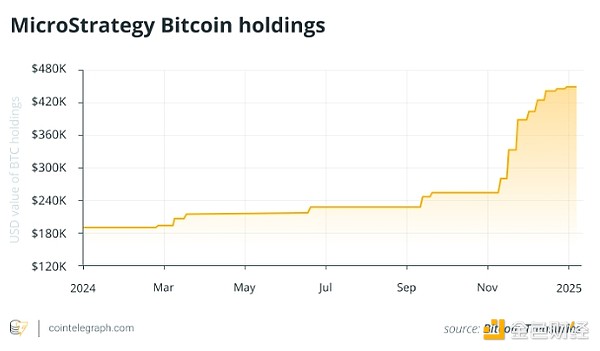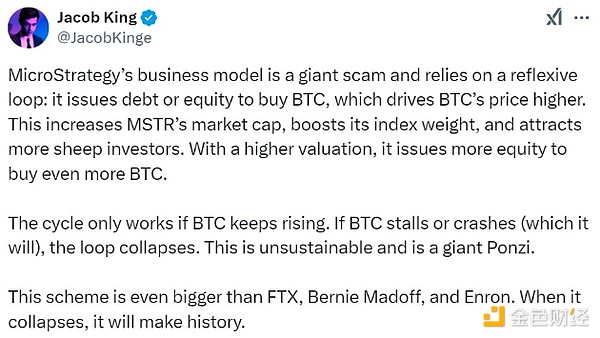Author: Yohan Yun, CoinTelegraph; Compiler: Deng Tong, Golden Finance
MicroStrategy co-founder Michael Saylor has adopted an aggressive Bitcoin acquisition strategy, which onlookers believe is either a genius vision or a reckless gamble.
The latter warned that MicroStrategy's heavy reliance on volatile assets such as Bitcoin is fraught with risks. A sharp drop in Bitcoin prices could put pressure on the company's balance sheet, exacerbating financial pressures and potentially weakening its ability to repay debts or raise additional funds.
Despite the risks, Saylor remains steadfast. The American entrepreneur said he has "no reason to sell the winner."
MicroStrategy is the world’s largest corporate Bitcoin holder, with 447,470 Bitcoins as of the time of publication. These large holdings increase risk for the company and the entire Bitcoin ecosystem.

Funding MicroStrategy’s BTC Purchases
MicroStrategy is nominally a business intelligence software company, but its aggressive Bitcoin accumulation means it is essentially a Bitcoin finance company.
Saylor's Bitcoin buying spree began with a $250 million company cash buy in August 2020. He then turned to debt issuance, starting with convertible notes -- debt that can be converted into equity. These notes, which typically carry low interest rates, helped raise $650 million in December 2020, and subsequent offerings have raised billions more.
In June 2021, MicroStrategy issued $500 million in senior secured notes, which offer higher interest rates and are backed by company assets.

Most recently, on December 24, 2024, MicroStrategy proposed to increase its common stock from 330 million to 10.33 billion shares and its preferred stock from 5 million to 1.005 billion shares. The plan provides flexibility to raise capital over time as needed, rather than issuing all new shares at once.
That fits into the company’s 21/21 plan, which aims to raise $42 billion over the next three years — half in stock sales and half in fixed-income instruments — to finance further bitcoin purchases and explore initiatives such as developing a crypto bank or offering bitcoin-based financial products.
A reckless Ponzi scheme?
David Krause, emeritus finance professor at Marquette University, said Saylor’s strategy was “inappropriate.”
A sharp drop in bitcoin prices could severely impact MicroStrategy (MSTR), eroding shareholder equity, jeopardizing debt repayments and potentially leading to financial distress or bankruptcy, triggering a sell-off in its shares, he warned.
“As someone who has spent much of his career researching and teaching corporate finance and investments, and has served as [chief financial officer] for more than a decade, I firmly believe that treasury assets should consist entirely of highly liquid and low-risk securities, such as money market instruments,” Kruger noted in a written statement.
MSTR has routinely traded at a premium to the net asset value (NAV) of its bitcoin holdings. On Jan. 9, the company’s bitcoin holdings accounted for 51% of its market value, according to data from BitcoinTreasuries.net.
When MSTR trades above its bitcoin NAV, the company raises funds through debt or equity to buy more bitcoin. However, Kruger warned that such a strategy could dilute shareholders.
In theory, this approach would create a cycle where a company’s bitcoin holdings would boost its market position and share price, leading to further bond issuance and more bitcoin purchases.
Some social media analysts have likened this circular strategy to a Ponzi scheme.
Financial analyst Jacob King said: "This cycle will only work if BTC continues to rise. If BTC stagnates or collapses (it will indeed collapse), the cycle will collapse. This is unsustainable and is a huge Ponzi scheme."

Source: Jacob King
In a recent media interview, Saylor The approach was compared to real estate practices in Manhattan.
"Like developers in Manhattan, every time real estate values go up, they issue more debt to develop more real estate," he said. "That's why the buildings in New York City are so tall, and it's been that way for 350 years. I call it economics."
Kruger has been critical of MicroStrategy's reliance on Bitcoin, which he said in a recent paper does not meet the U.S. Securities and Exchange Commission's formal definition of a Ponzi scheme.
The securities regulator describes a Ponzi scheme as "an investment fraud that involves paying purported returns to existing investors from funds invested by new investors."
Gracy Chen, CEO of cryptocurrency exchange Bitget, agreed with Kruger's analysis.
Unlike a Ponzi scheme, which relies on funds from new investors to pay returns to early investors, MicroStrategy's approach relies on market-driven appreciation in the value of Bitcoin. ”
Chen pointed out that “This strategy is more similar to Charles de Gaulle’s challenge to the Bretton Woods system by converting the dollar into gold. This is to take advantage of the known weaknesses in modern monetary theory to profit from asset appreciation. ”
Saylor’s Bitcoin blueprint has been an undeniable success
As of the close of trading on January 8, MSTR shares were trading at $331.70, up about 2,200% since the company first purchased Bitcoin on August 11, 2020, when it closed at $14.44. Over the same period, the price of Bitcoin has risen about 735%.
Whether or not one agrees with Saylor’s views, his plan has undoubtedly boosted MicroStrategy’s cryptocurrency portfolio and stock performance, allowing the company to become a member of the Nasdaq 100 Index in December.
While shareholders may face dilution, supporters believe that Bitcoin’s long-term growth potential can offset these risks.In addition, Chen noted that MicroStrategy 's convertible debt structure could act as a protective buffer during a crisis.
"A prolonged bear market could expose the company to liquidity challenges and heightened debt management risks. However, its unsecured convertible debt structure provides some protection from immediate forced liquidation," Chen explained.
The company's approach to raising funds through equity offerings further reduces the risk of selling its Bitcoin holdings even during a bear market."
Bitcoin Exit Strategy
In short, MicroStrategy's mission is simple: keep buying Bitcoin.
The asset is a long-term strategic holding, a hedge against economic uncertainty, and a means to enhance shareholder value. It can also be used to obtain loans or raise funds for future business opportunities without having to liquidate their Bitcoin.
"It is possible to profit from Bitcoin's large liquidity pool," said Alexander Panasenko, head of product management at VixiChain. “When you hold a lot of liquidity in this inflation-resistant asset that’s actually a store of value, you can make money just by holding it, lending it.”
Critics, however, point to Saylor’s lack of a clear exit strategy. Bitcoin maximalists, who see Bitcoin as the ultimate exit from the traditional financial system, argue that it’s unnecessary.
Stock dilution remains a looming issue, but the strategy has largely benefited MicroStrategy and the broader Bitcoin ecosystem, inspiring copycats around the world.
“As long as [MicroStrategy] continues to spark conversation about the role of digital assets in the future economy, and you see new companies adopting it more broadly, revealing new strategies to leverage digital assets ... that’s really good,” Panasenko said.
“If proposals like this involving digital assets fail, it’s going to cast a shadow over the entire industry and basically set us back.”
 Brian
Brian
 Brian
Brian Brian
Brian Joy
Joy Brian
Brian Kikyo
Kikyo Joy
Joy Edmund
Edmund Brian
Brian Joy
Joy JinseFinance
JinseFinance